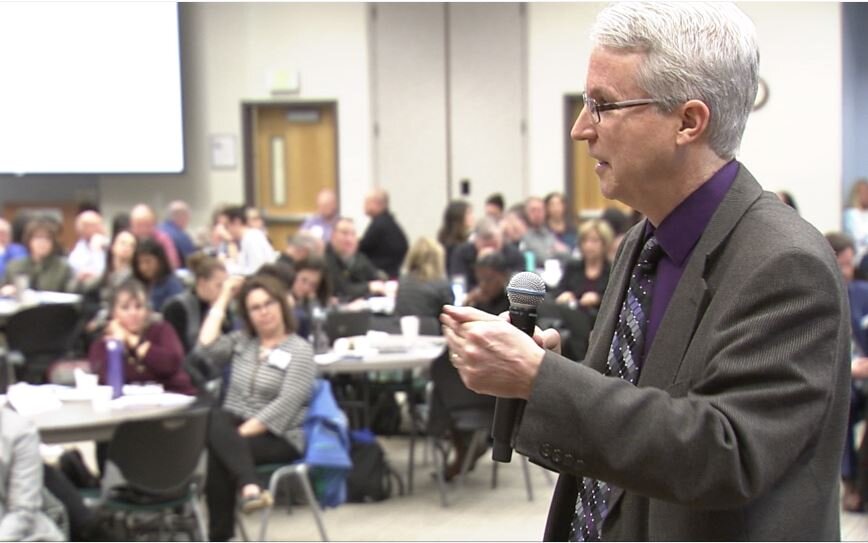Operation Gun Debate: Two Trauma Surgeon Brothers Talk Guns and Injuries

He is one of the most recognizable trauma surgeons in the country –if not because of his signature silver mustache and gravelly speaking voice – then because of his world-renowned reputation for literally writing the book on trauma surgery (it’s called Trauma).
Dr. Ernest Eugene Moore, “Gene,” has operated on thousands of people throughout his decades-long career and has written at least 1,700 scientific and medical papers.
He has made such an impact on patients and young surgeons that Denver Health, the premier public hospital in Colorado where he has served for more than 40 years, named the trauma center after him: the Ernest E. Moore Shock Trauma Center.
In recent months, however, Dr. Moore has become recognizable for his outspoken stance on semi-automatic rifles, like the AR-15.
“I don't think civilians should have access to an assault-type rifle because I think it has the potential for destructive violence on a mass of people who are innocent,” he said.
Moore, who owns multiple firearms and is an avid hunter, wrote about his concerns in an op-ed for NBC News after the Parkland, Florida school massacre at Marjory Stoneman Douglas High School in 2018.
But Moore’s own brother – Dr. John Moore, a Harvard-educated trauma surgeon, now retired – disagrees.
“I have an AR-15 and I enjoy it,” John Moore says.
On a scorching July day on John Moore’s farm outside of Denver, the brothers demonstrated how a high-powered rifle might impact the human body, using ballistic gelatin.
"It’s not a matter of what’s the most dangerous bullet, it really is how can you deliver the potential energy to kill people in a short time period, and I think that’s a big confusion in society,” said Gene Moore.
The two explained how the angle of the entry and contact with skin or bone could cause a bullet to spiral up and down, causing greater tissue destruction.
“Injuries aren’t dramatically different with handguns,” said Gene. “Where there is an exponential difference is when it comes to a rifle, like an AR-15 wound."
He said the amount of energy transmitted to the body and the ability to fire the weapon quickly give it a greater wounding capaticy.
“I don’t care who is available or what kind of alert system you have, the devastation is overwhelming with that kind of capacity to shoot,” he said.
Combined, the two have at least 75 years of trauma surgery experience. During their careers, they have operated on the same patients together, but they don’t always see eye to eye on the debate about who should have access semi-automatic rifles.
“I read the constitution, and I’m a big believer in the second amendment, and I think that the law-abiding citizen, like me, ought to be able to protect myself,” said John Moore, who owns 25 firearms including his AR-15. He also taught gun safety for the NRA in the 1980s.
While semi-automatic rifles have been used in four of the five deadliest mass shootings in the United States, John Moore says any negative reputation surrounding high-powered rifles like the AR-15 is unwarranted.
“That’s one of the misconceptions -- that everyone is being shot with a (semi-automatic rifle),” John Moore said. “I bet 85 percent minimum of homicides are committed with handguns as opposed to rifles.”
A Rocky Mountain PBS analysis of average FBI homicide data from 2015-2017, found handguns are used 92 percent of the time in homicides when the type of gun is known. The type of gun is unknown in about 30 percent of firearm homicide cases collected by the FBI.
John Moore said he is concerned law-abiding citizens will be negatively impacted if restrictions are placed semi-automatic rifles.
“There are a couple million of these that are in the hands of law-abiding citizens right now,” he said. “It is always a slippery slope. You take one right away, and then another right… I don’t want to see (the second amendment) nicked away and then finally we don’t have any guns.”
While the two have saved countless victims of gun violence, they have different opinions on how to prevent it.
“My ultimate desire would be to take away the assault rifle design,” said Gene Moore, adding that the amount of rounds a gun can hold is also an important factor in reducing violence. “I think a magazine capacity should be limited to five.”
John said regardless of any potential restrictions or new gun regulations, he believes a criminal is going to get a gun.
While the two don’t always support each other’s opinions, they do support having a civil conversation and discussing solutions that will ultimately bring fewer gunshot patients, especially school children, into the trauma room.
“It just isn’t politics. It’s a matter of trying to sit down with people and have facts and try to figure out how we can avoid the continued carnage we see in schools,” Gene Moore said. “We’re not going to break up a brotherhood because he’s pro and I’m anti.”
“There are so many issues in society that are backed on emotion and not fact,” John Moore added. “We need research.”



